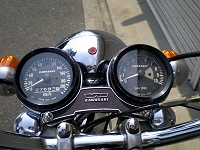|
Kawasaki W1 to W3
W-650, W1, W2, W2SS, Commander,
W2TT, W1S, W1SA, W3
| |
| |
|
|
|
|
|
|
| |
The W123
Story |
|
| |
|
|
|
|
|
|
| |
It
all began in England with the BSA A7 A10 parallel twins. (Se picture below.)
Around 1960 a Japanese manufacture, Meguro based their new
500ccm bike the K1 on the BSA A7/A10.
For
its day, the K1 (picture below) was an advanced design and
showcased modern-day manufacturing techniques with its
Air-Cooled , 4-stroke, 496cc
capacity, 360 degree parallel twin with overhead valves,
all mounted in a double-cradle frame.
And by 1960, Meguro
Works entered into a business arrangement with Kawasaki Aircraft Co, Ltd.
In 1963, Meguro
Works merged with Kawasaki Aircraft Co, Ltd, forming Kawasaki
Motor Sales Co. Soon to become Kawasaki Motorcycle Co,
Ltd. Kawasaki then made some small changes to the Meguro K1 and
made the K2. The Kawasaki K2 didn't sell very well so Kawasaki
soon decided to do something "hotter". The W1 was born in
October 1965
|
|
| |
|
|
| |
|
|
| |
|
|
| |
|
|
|
|
|
|
|
|
| |
| |
|
|
| |
|
The W models in
detail. |
 |
< >
Both the W1S, W2SS and
the W1SS got shorter
exhaust pipe and a
shorter rear fender |
 |
>
All except the 1969 and
newer W2SS and W2TT
models kept the classic
Kawasaki badge shown in
the picture on the right
side. |
 |
>
The engine vas basically
the same on all models.
The main difference was
an engine head with one
or two carburetors. W1S
with two carb's show
here. |
 |
>
Foot brake on left
side of the engine, and
the gear selector pedal
at right up until they
got it right with the
W1SA in 1971 |
 |
 |
 |
Left: W1S logo
Right W1SS logo.
The bike was called
W-650 in its home
country, Japan. |
 |
>
Separated instruments on
the W1S, late model W2SS
and the W2TT |
 |
| |
|
|
|
|
|
|
| |
|
|
|
|
|